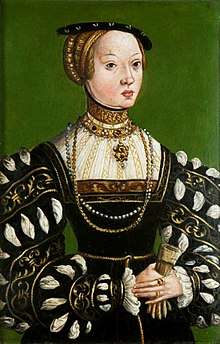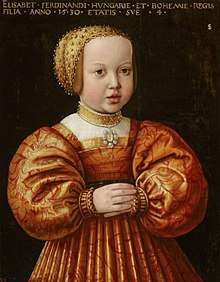Elizabeth of Austria (1526–1545)
Elizabeth of Austria (Polish: Elżbieta Habsburżanka; 9 July 1526 – 15 June 1545) was a Queen consort of Poland. She was the eldest of fifteen children of Ferdinand I, Holy Roman Emperor, and his wife Anne of Bohemia and Hungary.[1] A member of the House of Habsburg, she was married off to Sigismund II Augustus, who was already crowned as King of Poland and Grand Duke of Lithuania even though both of his parents were still alive and well. The marriage was short and unhappy. Elizabeth was of frail health, suffering from epileptic seizures, and died at age 18.
| Elizabeth of Austria | |
|---|---|
 Portrait by Lucas Cranach the Younger | |
| Queen consort of Poland Grand Duchess of Lithuania | |
| Tenure | 5 May 1543 – 15 June 1545 |
| Coronation | 8 May 1543 |
| Born | 9 July 1526 Linz |
| Died | 15 June 1545 (aged 18) Vilnius |
| Burial | 24 July 1545 |
| Spouse | Sigismund II Augustus |
| House | House of Habsburg |
| Father | Ferdinand I, Holy Roman Emperor |
| Mother | Anna of Bohemia and Hungary |
Marriage plans

Elizabeth spent most of her childhood in the Hofburg, Innsbruck. She was raised with strict discipline and received a good education from humanist Kaspar Ursinus Velius,[1] but was not taught the Polish language despite her early arranged marriage to Sigismund II Augustus.[2] The marriage plan was first discussed when Elizabeth was just one year old. Louis, King of Hungary and Bohemia, died in August 1526 without leaving an heir. The Hungarian throne was contested between Louis' brother-in-law Ferdinand I and John Zápolya.[2] Louis' uncle Sigismund I the Old and Hungarian nobility supported Zápolya. The marriage of Elizabeth to Sigismund's son was proposed as the means to discontinue Polish support to Zápolya.[2] Polish Queen Bona Sforza opposed the wedding as she opposed the growing influence of the Habsburgs.[3]
In February 1530, ten-year-old Sigismund II Augustus was co-crowned vivente rege as King of Poland (his father was still alive and of strong health) to secure his inheritance in Poland.[4] Envoys of George, Duke of Saxony, attended the coronation ceremony and negotiated the marriage between Elizabeth and Sigismund August on behalf of Ferdinand.[5] Great Chancellor of the Crown Krzysztof Szydłowiecki supported the wedding and organized a preliminary marriage treaty, signed on 10–11 November 1530 in Poznań.[5] According to the treaty, the marriage was to take place in 1533 when Elizabeth reached the age of 7. Her dowry was 100,000 ducats. In exchange, the Poles would grant her the cities of Nowy Sącz, Sanok, Przemyśl, Biecz.[5]
Sigismund Augustus and Elizabeth were first cousins once removed. (Casimir IV Jagiellon was a great-grandfather of Elizabeth and a grandfather of Sigismund August). This close relationship required a matrimonial dispensation, which was issued by Pope Clement VII on 24 August 1531.[5] The final marriage treaty, delayed mostly due to the opposition by Bona Sforza, was signed only on 16 June 1538 in Breslau ( now Wrocław) by Johannes Dantiscus.[5] The treaty did not differ from the preliminary treaty of 1530 other than the age of the bride which was now set at 16. The betrothal ceremony took place on 17 July 1538 in Innsbruck.[5] Bona continued to lobby against the marriage and instead proposed Princess Margaret of France.[6]
Queen of Poland
Elizabeth and a twelve-person escort departed Vienna on 21 April 1543.[7] She was met at Olomouc by Samuel Maciejowski, Bishop of Płock and a retinue of 1,500 knights. On 5 May 1543, Elizabeth entered Kraków and met Sigismund Augustus for the first time.[7] The same day 16-year-old Elizabeth married 22-year-old Sigismund Augustus in the Wawel Cathedral. The wedding celebration continued for two weeks. She was also crowned as Queen of Poland, which only increased the ire of Bona Sforza who detested her title of "Old Queen".[7]

The marriage was not happy. Sigismund Augustus, who already had several mistresses, did not find Elizabeth attractive and continued to have extramarital affairs.[8] Raised in a strict household to be obedient, Elizabeth was too timid and meek.[9] A long journey from Austria to Poland further deteriorated her frail health. She was diagnosed with epilepsy and started having seizures.[9] At the same time Bona openly expressed her dislike of Elizabeth and continued to search for ways to destroy the marriage. Bona questioned the wording of the matrimonial dispensation; a new dispensation was issued on 17 May 1544.[10] On the other hand, Polish nobility liked and sympathized with Elizabeth – a young, pleasant woman ignored by her husband and taunted by her ambitious mother-in-law.[11] Her father-in-law Sigismund I the Old was also sympathetic to her, but was too weak to protect her from Bona.[12]
Two months after the wedding, a plague reached Kraków and the royal family departed the capital city.[9] Sigismund Augustus left for the Grand Duchy of Lithuania, while Sigismund I the Old, Bona, and Elizabeth toured various cities in Poland. After a year of separation, the couple met in Brest.[13] Sigismund Augustus liked living independently in Lithuania and convinced his father to entrust him with ruling over the Grand Duchy.[13] In fall 1544, Elizabeth and Sigismund Augustus moved to Vilnius. For a few months Sigismund Augustus attempted to keep up appearances of a successful marriage to appease the Habsburgs, but soon started ignoring his wife and continued his affair with Barbara Radziwiłł.[13]
In April 1545, Elizabeth's health deteriorated and she was tormented by increasingly frequent seizures. On 8 June 1545, Sigismund Augustus went to Kraków to receive Elizabeth's dowry, leaving his wife alone in Vilnius.[13] In Kraków, Sigismund Augustus inquired about treatments and asked Ferdinand I to send his own doctors.[13] But it was too late. On 15 June, the young queen died exhausted by her many epileptic seizures. She was buried on 24 July 1545 (after her husband returned from Kraków) in Vilnius Cathedral next to her husband's uncle, King Alexander Jagiellon.[13]
After Elizabeth's death Sigismund Augustus married his mistress Barbara Radziwiłł and, after her death, Elizabeth's younger sister, Catherine of Austria. Sigismund had no children from his three wives.
Ancestors
References
| Wives of Sigismund II Augustus |
|---|
- Notes
- Duczmal (2012), p. 164
- Duczmal (2012), p. 165
- Duczmal (2012), pp. 165–167
- Duczmal (2012), p. 525
- Duczmal (2012), p. 166
- Duczmal (2012), pp. 166–167
- Duczmal (2012), p. 167
- Duczmal (2012), pp. 167–168
- Duczmal (2012), p. 168
- Duczmal (2012), p. 168–169
- Duczmal (2012), p. 170
- Duczmal (2012), p. 171
- Duczmal (2012), p. 169
- Holland, Arthur William (1911). . In Chisholm, Hugh (ed.). Encyclopædia Britannica. 17 (11th ed.). Cambridge University Press.
- Wurzbach, Constantin, von, ed. (1861). . Biographisches Lexikon des Kaiserthums Oesterreich [Biographical Encyclopedia of the Austrian Empire] (in German). 7. p. 112 – via Wikisource.
- Poupardin, René (1911). . In Chisholm, Hugh (ed.). Encyclopædia Britannica. 5 (11th ed.). Cambridge University Press.
- Ferdinand II, King of Spain at the Encyclopædia Britannica
- Chisholm, Hugh, ed. (1911). . Encyclopædia Britannica. 15 (11th ed.). Cambridge University Press.
- Isabella I, Queen of Spain at the Encyclopædia Britannica
- Casimir IV, King of Poland at the Encyclopædia Britannica
- Vladislas II, King of Bohemia and Hungary at the Encyclopædia Britannica
- Wurzbach, Constantin, von, ed. (1860). . Biographisches Lexikon des Kaiserthums Oesterreich [Biographical Encyclopedia of the Austrian Empire] (in German). 6. p. 167 – via Wikisource.
- Boureau, Alain (1995). The Lord's First Night: The Myth of the Droit de Cuissage. Translated by Cochrane, Lydia G. The University of Chicago Press. p. 96.
- Cazacu, Matei (2017). Reinert, Stephen W. (ed.). Dracula. Brill. p. 204.
- Noubel, P., ed. (1877). Revue de l'Agenais [Review of the Agenais]. 4. Société académique d'Agen. p. 497.
| Wikimedia Commons has media related to Elisabeth of Austria (1526-1545). |
- Bibliography
- Duczmal, Małgorzata (2012). Jogailaičiai (in Lithuanian). Translated by Birutė Mikalonienė; Vyturys Jarutis. Vilnius: Mokslo ir enciklopedijų leidybos centras. ISBN 978-5-420-01703-6.
External links
- Przemysław Jędrzejewski, ELŻBIETA AUSTRIACZKA – KRÓLOWA POLSKA I WIELKA KSIĘŻNA LITEWSKA (1526–1545)
Elizabeth of Austria Born: 9 July 1526 Died: 15 June 1545 | ||
| Royal titles | ||
|---|---|---|
| Preceded by Bona Sforza as sole queen |
Queen consort of Poland Grand Duchess consort of Lithuania 1543–1545 with Bona Sforza |
Succeeded by Bona Sforza as sole queen |